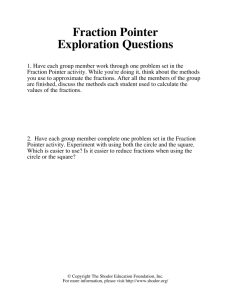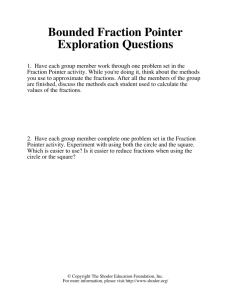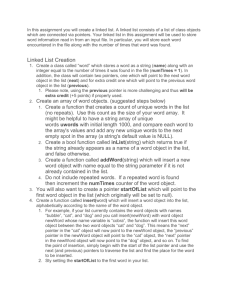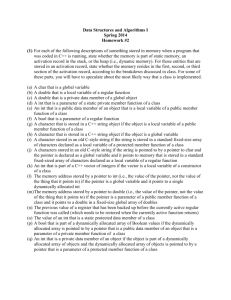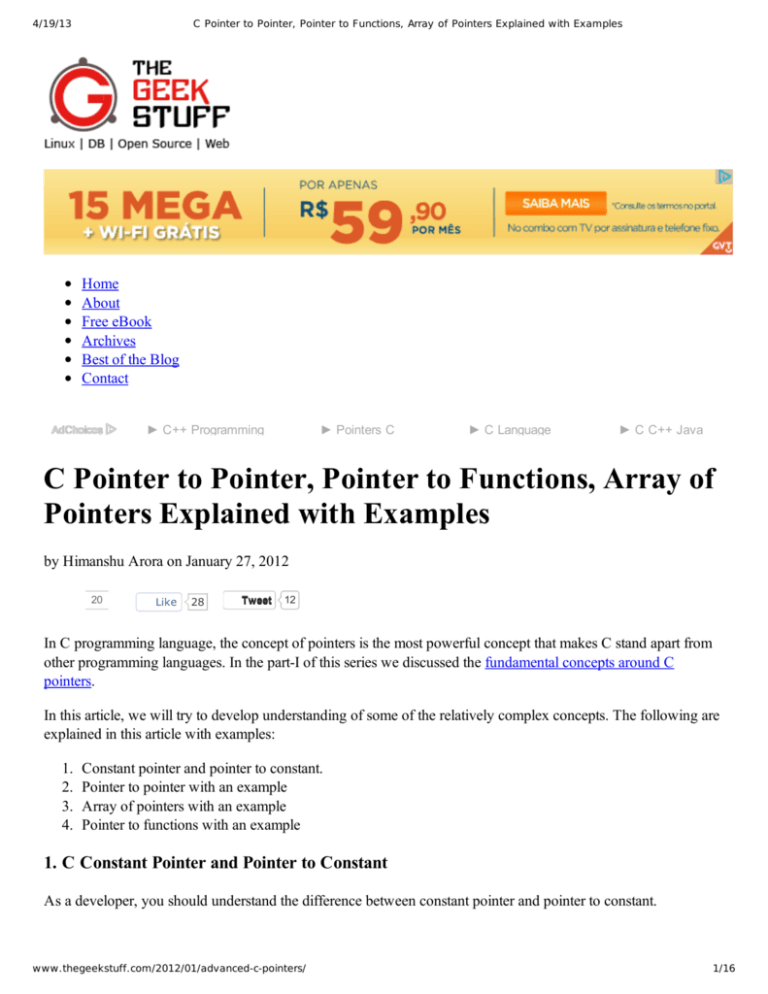
4/19/13
C Pointer to Pointer, Pointer to Functions, Array of Pointers Explained with Examples
Home
About
Free eBook
Archives
Best of the Blog
Contact
► C++ Programming
► Pointers C
► C Language
► C C++ Java
C Pointer to Pointer, Pointer to Functions, Array of
Pointers Explained with Examples
by Himanshu Arora on January 27, 2012
20
Like
28
Tweet
12
In C programming language, the concept of pointers is the most powerful concept that makes C stand apart from
other programming languages. In the part­I of this series we discussed the fundamental concepts around C
pointers.
In this article, we will try to develop understanding of some of the relatively complex concepts. The following are
explained in this article with examples:
1. 2. 3. 4. Constant pointer and pointer to constant.
Pointer to pointer with an example
Array of pointers with an example
Pointer to functions with an example
1. C Constant Pointer and Pointer to Constant
As a developer, you should understand the difference between constant pointer and pointer to constant.
www.thegeekstuff.com/2012/01/advanced-c-pointers/
1/16
4/19/13
C Pointer to Pointer, Pointer to Functions, Array of Pointers Explained with Examples
C Constant pointer
A pointer is said to be constant pointer when the address its pointing to cannot be changed.
Lets take an example :
char ch, c;
char *ptr = &ch
ptr = &c
In the above example we defined two characters (‘ch’ and ‘c’) and a character pointer ‘ptr’. First, the pointer ‘ptr’
contained the address of ‘ch’ and in the next line it contained the address of ‘c’. In other words, we can say that
Initially ‘ptr’ pointed to ‘ch’ and then it pointed to ‘c’.
But in case of a constant pointer, once a pointer holds an address, it cannot change it. This means a constant
pointer, if already pointing to an address, cannot point to a new address.
If we see the example above, then if ‘ptr’ would have been a constant pointer, then the third line would have not
been valid.
A constant pointer is declared as :
<type-of-pointer> *const <name-of-pointer>
For example :
#include<stdio.h>
int main(void)
{
char ch = 'c';
char c = 'a';
char *const ptr = &ch; // A constant pointer
ptr = &c; // Trying to assign new address to a constant pointer. WRONG!!!!
}
return 0;
www.thegeekstuff.com/2012/01/advanced-c-pointers/
2/16
4/19/13
C Pointer to Pointer, Pointer to Functions, Array of Pointers Explained with Examples
When the code above is compiled, compiler gives the following error :
$ gcc -Wall constptr.c -o constptr
constptr.c: In function ‘main’:
constptr.c:9: error: assignment of read-only variable ‘ptr’
So we see that, as expected, compiler throws an error since we tried to change the address held by constant
pointer.
Now, we should be clear with this concept. Lets move on.
C Pointer to Constant
This concept is easy to understand as the name simplifies the concept. Yes, as the name itself suggests, this type of
pointer cannot change the value at the address pointed by it.
Lets understand this through an example :
char ch = 'c';
char *ptr = &ch
*ptr = 'a';
In the above example, we used a character pointer ‘ptr’ that points to character ‘ch’. In the last line, we change the
value at address pointer by ‘ptr’. But if this would have been a pointer to a constant, then the last line would have
been invalid because a pointer to a constant cannot change the value at the address its pointing to.
A pointer to a constant is declared as :
const <type-of-pointer> *<name-of-pointer>;
For example :
#include<stdio.h>
int main(void)
{
char ch = 'c';
const char *ptr = &ch; // A constant pointer 'ptr' pointing to 'ch'
*ptr = 'a';// WRONG!!! Cannot change the value at address pointed by 'ptr'.
}
return 0;
When the above code was compiled, compiler gave the following error :
$ gcc -Wall ptr2const.c -o ptr2const
ptr2const.c: In function ‘main’:
ptr2const.c:7: error: assignment of read-only location ‘*ptr’
So now we know the reason behind the error above ie we cannot change the value pointed to by a constant
pointer.
2. C Pointer to Pointer
www.thegeekstuff.com/2012/01/advanced-c-pointers/
3/16
4/19/13
C Pointer to Pointer, Pointer to Functions, Array of Pointers Explained with Examples
Till now we have used or learned pointer to a data type like character, integer etc. But in this section we will learn
about pointers pointing to pointers.
As the definition of pointer says that its a special variable that can store the address of an other variable. Then the
other variable can very well be a pointer. This means that its perfectly legal for a pointer to be pointing to another
pointer.
Lets suppose we have a pointer ‘p1′ that points to yet another pointer ‘p2′ that points to a character ‘ch’. In
memory, the three variables can be visualized as :
So we can see that in memory, pointer p1 holds the address of pointer p2. Pointer p2 holds the address of
character ‘ch’.
So ‘p2′ is pointer to character ‘ch’, while ‘p1′ is pointer to ‘p2′ or we can also say that ‘p2′ is a pointer to pointer
to character ‘ch’.
Now, in code ‘p2′ can be declared as :
char *p2 = &ch;
But ‘p1′ is declared as :
char **p1 = &p2;
So we see that ‘p1′ is a double pointer (ie pointer to a pointer to a character) and hence the two *s in declaration.
Now,
‘p1′ is the address of ‘p2′ ie 5000
‘*p1′ is the value held by ‘p2′ ie 8000
‘**p1′ is the value at 8000 ie ‘c’
I think that should pretty much clear the concept, lets take a small example :
#include<stdio.h>
int main(void)
{
char **ptr = NULL;
www.thegeekstuff.com/2012/01/advanced-c-pointers/
4/16
4/19/13
C Pointer to Pointer, Pointer to Functions, Array of Pointers Explained with Examples
char *p = NULL;
char c = 'd';
p = &c;
ptr = &p;
printf("\n c = [%c]\n",c);
printf("\n *p = [%c]\n",*p);
printf("\n **ptr = [%c]\n",**ptr);
}
return 0;
Here is the output :
$ ./doubleptr
c = [d]
*p = [d]
**ptr = [d]
3. C Array of Pointers
Just like array of integers or characters, there can be array of pointers too.
An array of pointers can be declared as :
<type> *<name>[<number-of-elements];
For example :
char *ptr[3];
The above line declares an array of three character pointers.
Lets take a working example :
#include<stdio.h>
int main(void)
{
char *p1 = "Himanshu";
char *p2 = "Arora";
char *p3 = "India";
char *arr[3];
arr[0] = p1;
arr[1] = p2;
arr[2] = p3;
printf("\n p1 = [%s] \n",p1);
printf("\n p2 = [%s] \n",p2);
printf("\n p3 = [%s] \n",p3);
www.thegeekstuff.com/2012/01/advanced-c-pointers/
5/16
4/19/13
C Pointer to Pointer, Pointer to Functions, Array of Pointers Explained with Examples
printf("\n arr[0] = [%s] \n",arr[0]);
printf("\n arr[1] = [%s] \n",arr[1]);
printf("\n arr[2] = [%s] \n",arr[2]);
}
return 0;
In the above code, we took three pointers pointing to three strings. Then we declared an array that can contain
three pointers. We assigned the pointers ‘p1′, ‘p2′ and ‘p3′ to the 0,1 and 2 index of array. Let’s see the output :
$ ./arrayofptr
p1 = [Himanshu]
p2 = [Arora]
p3 = [India]
arr[0] = [Himanshu]
arr[1] = [Arora]
arr[2] = [India]
So we see that array now holds the address of strings.
4. C Function Pointers
Just like pointer to characters, integers etc, we can have pointers to functions.
A function pointer can be declared as :
<return type of function> (*<name of pointer>) (type of function arguments)
For example :
int (*fptr)(int, int)
The above line declares a function pointer ‘fptr’ that can point to a function whose return type is ‘int’ and takes
two integers as arguments.
Lets take a working example :
#include<stdio.h>
int func (int a, int b)
{
printf("\n a = %d\n",a);
printf("\n b = %d\n",b);
}
return 0;
int main(void)
{
int(*fptr)(int,int); // Function pointer
www.thegeekstuff.com/2012/01/advanced-c-pointers/
6/16
4/19/13
C Pointer to Pointer, Pointer to Functions, Array of Pointers Explained with Examples
fptr = func; // Assign address to function pointer
func(2,3);
fptr(2,3);
}
return 0;
In the above example, we defined a function ‘func’ that takes two integers as inputs and returns an integer. In the
main() function, we declare a function pointer ‘fptr’ and then assign value to it. Note that, name of the function
can be treated as starting address of the function so we can assign the address of function to function pointer using
function’s name. Lets see the output :
$ ./fptr
a=2
b=3
a=2
b=3
So from the output we see that calling the function through function pointer produces the same output as calling
the function from its name.
To conclude, in this article we touched some of the advanced concepts related to pointers. There can be some
interesting problems related to pointers, which we might cover in some future article.
20
Tweet
12
Like
28
> Add your comment
Linux provides several powerful administrative tools and utilities which will help
you to manage your systems effectively. If you don’t know what these tools are and how to use them, you could
be spending lot of time trying to perform even the basic administrative tasks. The focus of this course is to help
you understand system administration tools, which will help you to become an effective Linux system
administrator.
Get the Linux Sysadmin Course Now!
If you enjoyed this article, you might also like..
1. 50 Linux Sysadmin Tutorials
www.thegeekstuff.com/2012/01/advanced-c-pointers/
Awk Introduction – 7 Awk Print Examples
7/16
4/19/13
C Pointer to Pointer, Pointer to Functions, Array of Pointers Explained with Examples
2. 50 Most Frequently Used Linux Commands (With
Examples)
3. Top 25 Best Linux Performance Monitoring and
Debugging Tools
4. Mommy, I found it! – 15 Practical Linux Find
Command Examples
5. Linux 101 Hacks 2nd Edition eBook Advanced Sed Substitution Examples
8 Essential Vim Editor Navigation
Fundamentals
25 Most Frequently Used Linux IPTables
Rules Examples
Turbocharge PuTTY with 12 Powerful Add­
Ons
{ 53 comments… read them below or add one }
1 cee January 27, 2012 at 3:43 am
Hi,
This article is so good, I will print it out for my apprentice (and myself).
It would be nice if this blog had a ‘print this site with all pictures and the whole formatting’ option.
Best Regards,
cee
2 Himanshu January 27, 2012 at 4:18 am
@cee
Thanks!!!
3 Makis January 27, 2012 at 6:40 am
Very nice examples. Good work! I believe it would also be nice to cover some dynamic memory
fundamentals using pointers (ie dynamic single and two­dimensional arrays). Also consider the possibility
of covering this dynamic memory tutorial not only for C but also for the C++ language.
4 apol January 27, 2012 at 12:12 pm
Yeah ! you’ve wrote it as you said before the end of january Thanks a lot for this article and your site in
general.
www.thegeekstuff.com/2012/01/advanced-c-pointers/
8/16
4/19/13
C Pointer to Pointer, Pointer to Functions, Array of Pointers Explained with Examples
5 Jay January 29, 2012 at 4:20 am
The article is very nice..and useful as well.
If the uses mentioned then it would be more and more helpful.
6 Balakrishnan M February 6, 2012 at 12:44 am
Clearly explained.. Useful one !!
7 divya March 28, 2012 at 8:35 am
explanation and article both are very nice ……..:)
8 priya April 15, 2012 at 2:45 am
thnk u so much..ifor giving such difficult concept in a nice manner…
9 raj May 19, 2012 at 12:27 pm
good explanation with examples……………..!!!thanks
10 Dev June 3, 2012 at 7:43 am
Awesome article . hope will get advance article also ..
Thanks a lot. Really appreciate ur effort 11 Max steel June 8, 2012 at 12:48 pm
Awesome work man…!!! I be gained my comfort level wid ptr by ur article…thanks..
12 Anonymous June 14, 2012 at 4:53 pm
Great article, it contained great detail and simple explanations of pointers.
Thanks.
13 samadhan July 5, 2012 at 7:57 am
u have explain the concept in nicely in manner,
easy to understand
14 zah July 24, 2012 at 4:12 am
Thanks for this article mayn!! really useful! I think I got what i needed for my interview!!
Thanks,
Best regards!!
15 sony July 26, 2012 at 3:25 am
hiiiiiiii
this article is really good it helps us lot in understnading pointer and its working
www.thegeekstuff.com/2012/01/advanced-c-pointers/
9/16
4/19/13
C Pointer to Pointer, Pointer to Functions, Array of Pointers Explained with Examples
Thanks.
16 shari July 26, 2012 at 5:37 am
simple and clean!
17 BB July 30, 2012 at 12:36 am
Useful peace of info 18 Nagarajan August 1, 2012 at 10:48 am
I have learnt so much from geekstuff especially this made pointer concepts very clear!!
Thank you 19 Syed Shareef Ali August 10, 2012 at 1:15 am
Awesome!!!…Very good article with clear information.
Like to know few more advanced topics.!!Please point the similar links.
20 Krishnakumar gupta August 17, 2012 at 4:22 am
Hi
This Artical is very good and easy to understand
i want to know more advance concepts of pointer
if you have please send me on my emailid
21 Mayank August 22, 2012 at 11:36 pm
Can you please suggest some good book to go into more detail of understanding and working on pointers?
22 lala August 30, 2012 at 12:12 am
concept is describedn in very simple way i like it
23 Mihai bairac September 5, 2012 at 5:20 am
Great article! Thank you!
24 kalpana b September 14, 2012 at 6:06 am
This article is easy to understand and very helpful…
Thanks a lot!!
25 Ranjith Kumar September 21, 2012 at 7:33 am
#include
int main(void)
{
char **ptr=NULL;
www.thegeekstuff.com/2012/01/advanced-c-pointers/
10/16
4/19/13
C Pointer to Pointer, Pointer to Functions, Array of Pointers Explained with Examples
char *p=NULL;
char c=”d”;
p=&c;
ptr=&p;
printf(“\n c=[%c] \n”,c);
printf(“\n *p=[%c] \n”,*p);
printf(“**ptr=[%c] \n”,**ptr);
return(0);
}
26 Ramesh September 22, 2012 at 3:01 am
Nice explanation…
27 raju September 22, 2012 at 5:30 am
char ch, c;
char *ptr = &ch
ptr = &c
28 Niranjan September 26, 2012 at 10:45 pm
Hi everybody i want 5­10 questions and solutions in­depth on pointers please help me
29 Anonymous October 1, 2012 at 2:28 pm
“”
So we can see that in memory, pointer p1 holds the address of pointer p2. Pointer p2 holds the address of
character ‘ch’.
So ‘p2′ is pointer to character ‘ch’, while ‘p1′ is pointer to ‘p2′ or we can also say that ‘p2′ is a pointer to
pointer to character ‘ch’.
“”
You have a typo in this paragraph.
its p1 with is pointer to pointer to character ch not p2
30 pari October 3, 2012 at 2:41 pm
Brief
And useful ,thanks alot!
31 sibusiso October 10, 2012 at 5:42 am
Brief , to the point and very useful. thanks a Million.
32 SURBHI JAIN October 16, 2012 at 3:00 am
Easy to understand pointers through this article.
www.thegeekstuff.com/2012/01/advanced-c-pointers/
11/16
4/19/13
C Pointer to Pointer, Pointer to Functions, Array of Pointers Explained with Examples
33 Pranoti October 21, 2012 at 2:43 am
Thank you very much for giving concepts of pointer that to in easy way. I like the way to put the example
to under each concept of pointer,pointer to array,function pointers.
Thanks…:)
34 sarita October 21, 2012 at 9:22 am
thanks!
35 Deepika October 30, 2012 at 1:53 am
Example and explanation both are goood…
36 ashutosh November 1, 2012 at 9:28 am
if int variable holds 2 bytes than what should pointer int occupy?????????? i.e int a=5 means a occupy 2
bytes and int *a where a=&a; than what should *a occupy in memory???????????
37 Neeti November 6, 2012 at 9:03 am
Thanks
38 pavithra November 6, 2012 at 10:54 am
Thank you…a very neat explanation
what does this statement mean
int (*ptr)[3] = &a[0];
39 Harsha P M November 13, 2012 at 5:07 am
can u tell about pointer to an array i.e int (*p)[10];.and also performance between
array of pointers n pointer to an array
40 A. Das November 19, 2012 at 9:23 am
This article really helped. Thank You.
41 Kush Sahni November 23, 2012 at 8:09 am
Nice and easy way to explain pointers..!! good job
42 Alok November 28, 2012 at 11:19 am
Very nicely explained. This really helped.
43 Anonymous November 29, 2012 at 1:15 am
int (*p)[10]; can u tell about pointer to an array in the same site. ur doing a good job…hatsoff…
44 Sandip pawar December 1, 2012 at 9:17 pm
www.thegeekstuff.com/2012/01/advanced-c-pointers/
12/16
4/19/13
C Pointer to Pointer, Pointer to Functions, Array of Pointers Explained with Examples
Ok,i can ustand
45 Anoop December 13, 2012 at 11:04 pm
Can you please implement the Inheritance concept in C using function pointer?
46 Ujjwal December 29, 2012 at 5:40 am
Above deceleration of every definition is very easy to understand……
nice job buddy……….
47 zubair January 28, 2013 at 12:21 pm
this is very gud can you tell me the other example more
48 Bharath January 31, 2013 at 11:54 am
above described ex are nice.but i advice you to provide much more examples.
49 sajan palakkad February 24, 2013 at 8:33 am
yes it’s realy hlpful
thnks
50 jignesh March 5, 2013 at 1:26 am
realy it’s very nice………….
51 Manikandan March 21, 2013 at 11:07 pm
Good to begin with
52 raj March 31, 2013 at 8:21 am
simple and very easy to understand
53 vijay chauhan April 6, 2013 at 11:32 am
superb!!! Easy to understand and very helpful as well..keep it up!
Leave a Comment
Name
E­mail
Website
www.thegeekstuff.com/2012/01/advanced-c-pointers/
13/16
4/19/13
C Pointer to Pointer, Pointer to Functions, Array of Pointers Explained with Examples
Notify me of followup comments via e­mail
Submit
Previous post: Linux Time Command Examples
Next post: 5 Useful Perl 5.10 Features – Say, State, ~~, Defined OR
Search
>Email >RSS >Twitter >Facebook COURSE
Linux Sysadmin CentOS 6 Course ­ Master the Tools, Configure it Right, and be Lazy
EBOOKS
Linux 101 Hacks 2nd Edition eBook ­ Practical Examples to Build a Strong Foundation in
Linux
Bash 101 Hacks eBook ­ Take Control of Your Bash Command Line and Shell Scripting
Sed and Awk 101 Hacks eBook ­ Enhance Your UNIX / Linux Life with Sed and Awk
Vim 101 Hacks eBook ­ Practical Examples for Becoming Fast and Productive in Vim Editor
Nagios Core 3 eBook ­ Monitor Everything, Be Proactive, and Sleep Well
www.thegeekstuff.com/2012/01/advanced-c-pointers/
14/16
4/19/13
C Pointer to Pointer, Pointer to Functions, Array of Pointers Explained with Examples
POPULAR POSTS
12 Amazing and Essential Linux Books To Enrich Your Brain and Library
50 UNIX / Linux Sysadmin Tutorials
50 Most Frequently Used UNIX / Linux Commands (With Examples)
How To Be Productive and Get Things Done Using GTD
30 Things To Do When you are Bored and have a Computer
Linux Directory Structure (File System Structure) Explained with Examples
Linux Crontab: 15 Awesome Cron Job Examples
Get a Grip on the Grep! – 15 Practical Grep Command Examples
Unix LS Command: 15 Practical Examples
15 Examples To Master Linux Command Line History
Top 10 Open Source Bug Tracking System
Vi and Vim Macro Tutorial: How To Record and Play
Mommy, I found it! ­­ 15 Practical Linux Find Command Examples
15 Awesome Gmail Tips and Tricks
15 Awesome Google Search Tips and Tricks
RAID 0, RAID 1, RAID 5, RAID 10 Explained with Diagrams
Can You Top This? 15 Practical Linux Top Command Examples
Top 5 Best System Monitoring Tools
Top 5 Best Linux OS Distributions
How To Monitor Remote Linux Host using Nagios 3.0
Awk Introduction Tutorial – 7 Awk Print Examples
How to Backup Linux? 15 rsync Command Examples
The Ultimate Wget Download Guide With 15 Awesome Examples
Top 5 Best Linux Text Editors
Packet Analyzer: 15 TCPDUMP Command Examples
The Ultimate Bash Array Tutorial with 15 Examples
3 Steps to Perform SSH Login Without Password Using ssh­keygen & ssh­copy­id
Unix Sed Tutorial: Advanced Sed Substitution Examples
UNIX / Linux: 10 Netstat Command Examples
The Ultimate Guide for Creating Strong Passwords
6 Steps to Secure Your Home Wireless Network
Turbocharge PuTTY with 12 Powerful Add­Ons
About The Geek Stuff
My name is Ramesh Natarajan. I will be posting instruction guides, how­to,
troubleshooting tips and tricks on Linux, database, hardware, security and web. My focus is to write articles
that will either teach you or help you resolve a problem. Read more about Ramesh Natarajan and the blog.
www.thegeekstuff.com/2012/01/advanced-c-pointers/
15/16
4/19/13
C Pointer to Pointer, Pointer to Functions, Array of Pointers Explained with Examples
Support Us
Support this blog by purchasing one of my ebooks. Bash 101 Hacks eBook Sed and Awk 101 Hacks eBook Vim 101 Hacks eBook Nagios Core 3 eBook
Contact Us
Email Me : Use this Contact Form to get in touch me with your comments, questions or suggestions about
this site. You can also simply drop me a line to say hello!. Follow us on Twitter Become a fan on Facebook Copyright © 2008–2013 Ramesh Natarajan. All rights reserved | Terms of Service | Advertise
www.thegeekstuff.com/2012/01/advanced-c-pointers/
16/16


